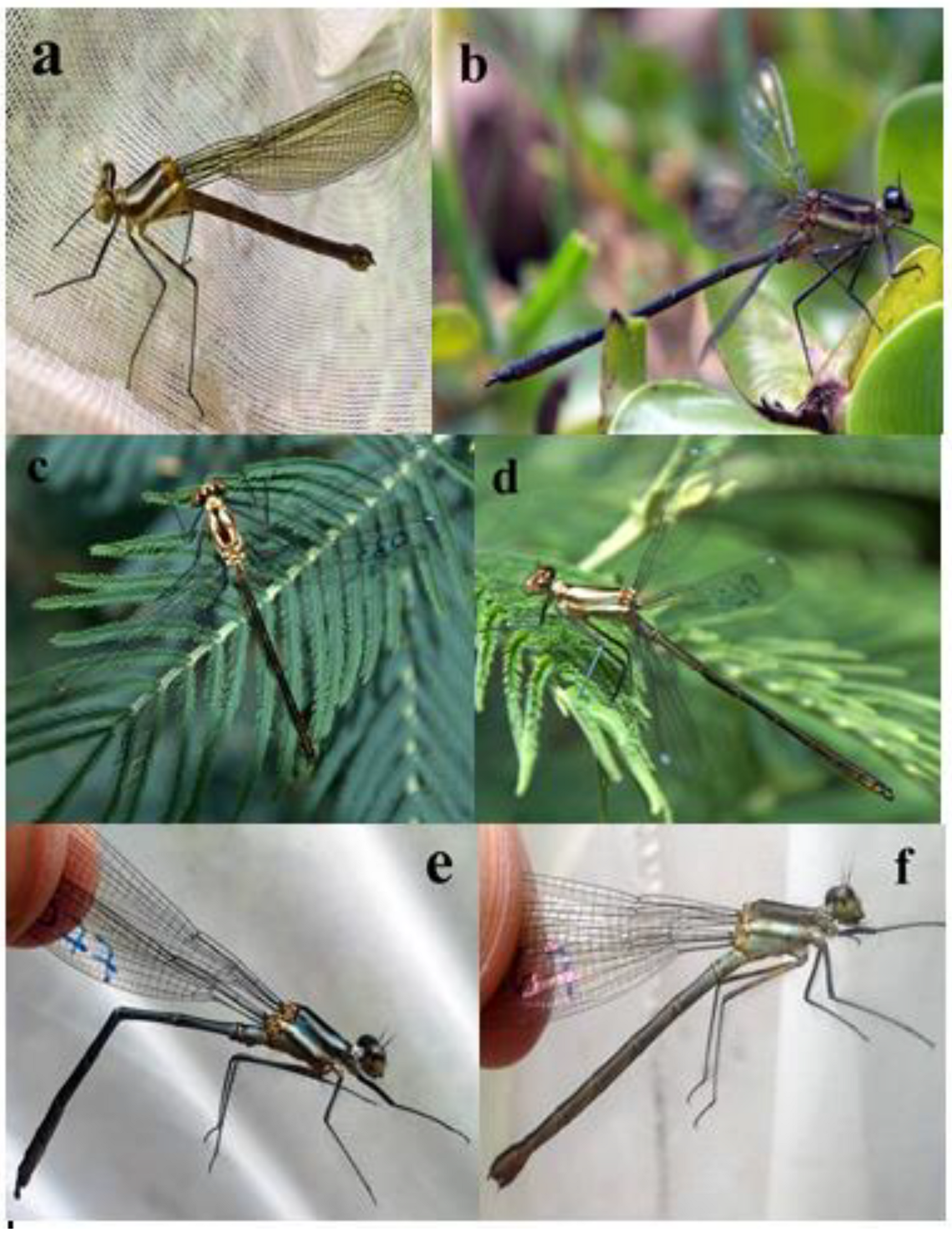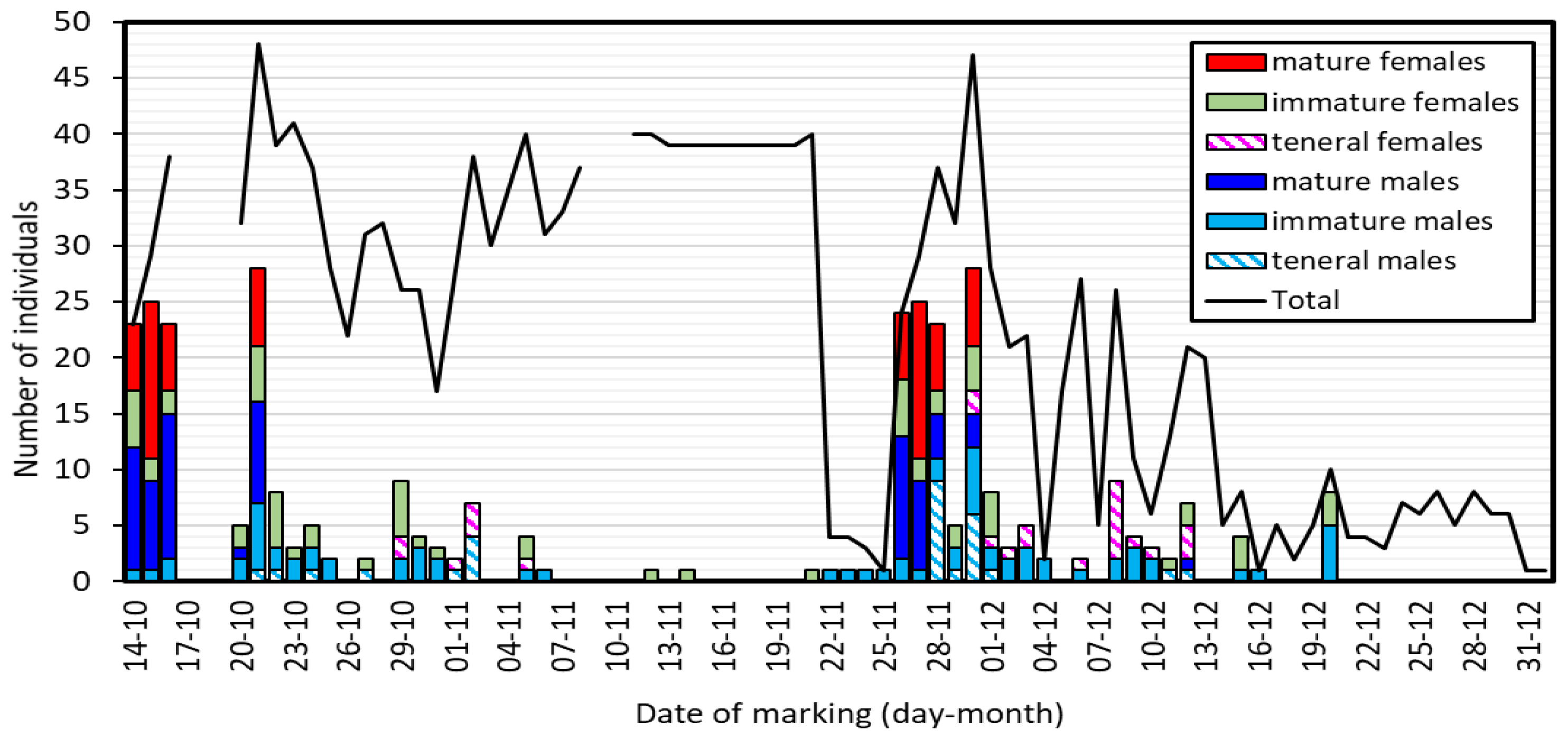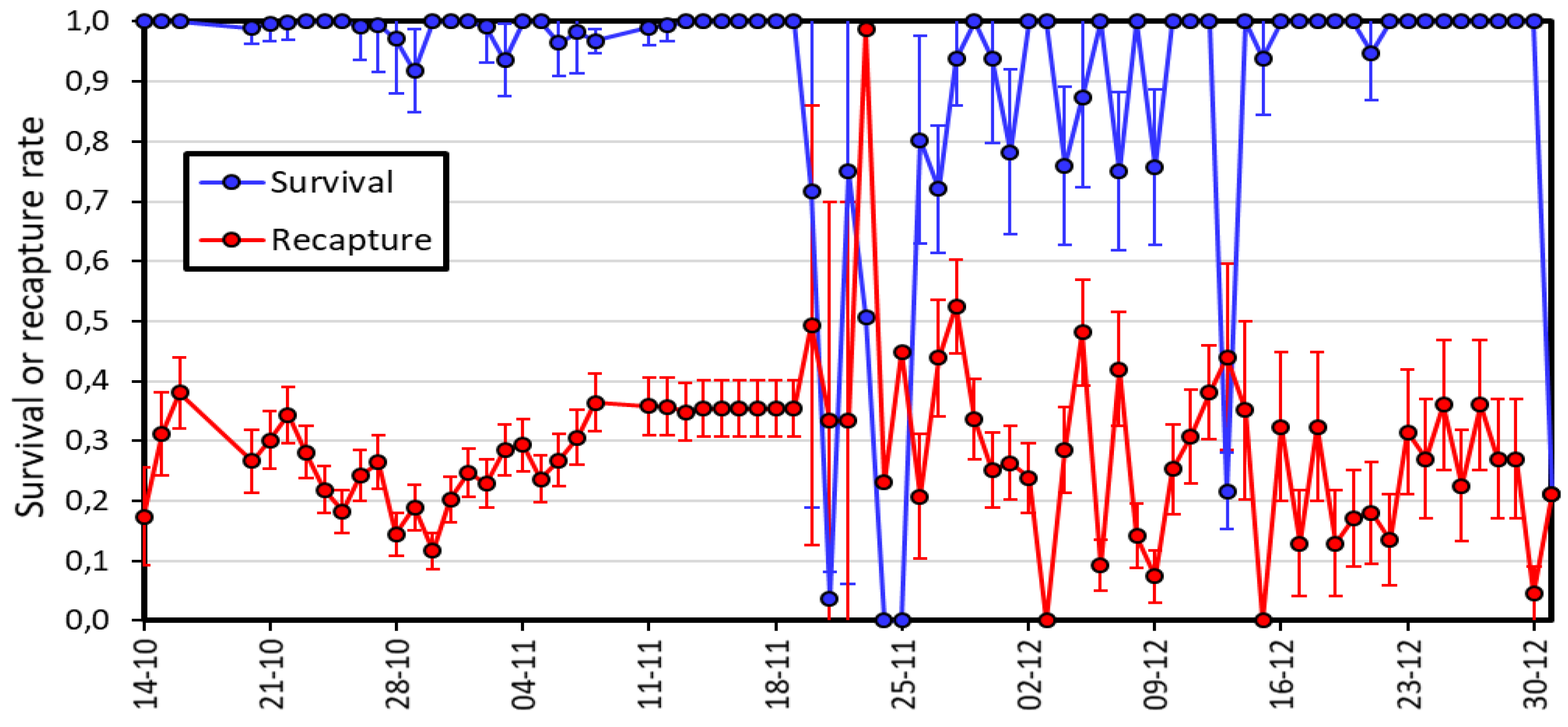Submitted:
15 January 2024
Posted:
16 January 2024
You are already at the latest version
Abstract
Keywords:
1. Introduction
2. Materials and Methods
Study area
Study species
Data Collection
Behavioral study
Statistical Analyses
3. Results
Biometry and population structure
Survival and recapture rates
Behavior
4. Discussion
Supplementary Materials
Author Contributions
Funding
Data Availability Statement
Acknowledgments
Conflicts of Interest
References
- King, R. C. Handbook of Genetics: Volume 4 Vertebrates of Genetic Interest. (Springer US, 1975). [CrossRef]
- Morin, J. G. & Hastings, J. W. Biochemistry of the bioluminescence of colonial hydroids and other coelenterates. J. Cell. Physiol. 1971, 77, 305–312. [Google Scholar] [PubMed]
- Naranjo, S. E. Influence of Two Mass-Marking Techniques on Survival and Flight Behavior of Diabrotica virgifera virgifera (Coleoptera: Chrysomelidae). J. Econ. Entomol. 1990, 83, 1360–1364. [Google Scholar] [CrossRef]
- Davenport, D. & Nicol, J. A. C. Luminescence in Hydromedusae. Proc. R. Soc. Lond. Ser. B 1955, 144, 399–411. [Google Scholar]
- Bartlett, A. C. Isozyme Polymorphism in Populations of the Pink Bollworm12. Ann. Entomol. Soc. Am. 1981, 74, 9–13. [Google Scholar] [CrossRef]
- Fernandes, O. A. , Wright, R. J., Baumgarten, K. H. & Mayo, Z. B. Use of Rubidium to Label Lysiphlebus testaceipes (Hymenoptera: Braconidae), a Parasitoid of Greenbugs (Homoptera: Aphididae), for Dispersal Studies. Environ. Entomol. 1997, 26, 1167–1172. [Google Scholar]
- Kapp, R. O. How to Know Pollen and Spores; W. C. Brown Company, 1969. [Google Scholar]
- Carey, J. R. Insect biodemography. Annu. Rev. Entomol. 2001, 46, 79–110. [Google Scholar] [CrossRef] [PubMed]
- Kéry, M. & Schaub, M. Bayesian Population Analysis Using WinBUGS: A Hierarchical Perspective; Academic Press, 2012. [Google Scholar]
- Lebreton, J.-D. , Burnham, K. P., Clobert, J. & Anderson, D. R. Modeling Survival and Testing Biological Hypotheses Using Marked Animals: A Unified Approach with Case Studies. Ecol. Monogr. 1992, 62, 67–118. [Google Scholar]
- Cordero-Rivera, A. & Stoks, R. Mark–recapture studies and demography. in Dragonflies and Damselflies: Model Organisms for Ecological and Evolutionary Research (ed. Córdoba-Aguilar, A.) 0 (Oxford University Press, 2008). [CrossRef]
- Sanmartín-Villar, I. & Cordero-Rivera, A. Odonata survival: Insights from mark-recapture experiments. in 129–140 (2022). [CrossRef]
- Altamiranda-Saavedra, M. & Ortega, O. Estructura poblacional de Polythore gigantea (Odonata: Polythoridae) en sistemas lóticos con diferentes estados de conservación en Antioquia, Colombia. Rev. Biol. Trop. 2012, 60, 1205–1216. [Google Scholar]
- Palacino Rodríguez, F. , Sánchez Contreras, N. & Córdoba-Aguilar, A. Population structure in dry and rainy seasons in Erythrodiplax umbrata (Linnaeus, 1758) (Odonata: Libellulidae). Odonatologica 2012, 41, 245–249. [Google Scholar]
- Palacino-Rodríguez, F. , Munguía-Steyer, R., Mesa-Blanco, L. V., Contreras-Sánchez, N. & Córdoba-Aguilar, A. Survival is predicted by territorial status but not wing pigmentation in males of a polythorid damselfly, Euthore fasciata (Odonata: Zygoptera: Polythoridae). Int. J. Odonatol. 2016, 19, 183–190. [Google Scholar]
- Rivas-Torres, A. , Sanmartín-Villar, I., Gabela-Flores, M. V. & Cordero-Rivera, A. Demographics and behaviour of Heteragrion cooki, a forest damselfly endemic to Ecuador (Odonata). Int. J. Odonatol. 2017, 20, 123–135. [Google Scholar]
- Rivas-Torres, A. , Sánchez-Guillén, R. A. & Cordero-Rivera, A. Alternative reproductive strategies in black-winged territorial males of Paraphlebia zoe (Odonata, Thaumatoneuridae). PeerJ 2019, 7, e6489. [Google Scholar] [PubMed]
- Palacino-Rodríguez, F. , Altamiranda-Saavedra, M., Andrés Palacino, D. & Carolina Penagos, A. Ecology of Mesamphiagrion laterale (Odonata: Coenagrionidae): abundance, reproduction and interactions with co-occurring species. Int. J. Odonatol. 2020, 23, 165–182. [Google Scholar]
- Palacino–Rodríguez, F. , Palacino, D. A., Munguia-Steyer, R. & Juen, L. Effects of seasonality and environmental change on an Andean damselfly Mesamphiagrion laterale (Odonata: Coenagrionidae). J. Insect Conserv. 2020, 24, 499–511. [Google Scholar]
- García-Monsalve, M. , Altamiranda-Saavedra, M., Palacino Rodríguez, F. & Cordero-Rivera, A. Demographic Traits and Behavior of Hetaerina cruentata (Odonata: Calopterygidae) in Ecosystems of the Andean Region of Colombia. Int. J. Odonatol. 2021, 24, 261–273. [Google Scholar]
- Ellenrieder, N. The larvae of Teinopodagrion decipiens De Marmels, 2001 and T. meridionale De Marmels, 2001 (Zygoptera: Megapodagrionidae). Odonatologica 2006, 35, 281–287. [Google Scholar]
- Palacino-Rodríguez, F. , Altamiranda-Saavedra, M. A., Palacino-Penagos, D. A., Penagos-Arévalo, A. C. & Ríos-Olaya, K. J. Factors influencing predation on Odonata by Argiope trifasciata (Forsskål, 1775). Int. J. Odonatol. 2023, 26, 36–43. [Google Scholar]
- Alvarez, C. , Álvarez Covelli, M. & Palacino Rodríguez, F. Abdomen or wings? Comparing two body places for marking in Mesamphiagrion laterale (Odonata: Coenagrionidae). Odonatologica 2015, 44, 343–348. [Google Scholar]
- Palacino Rodríguez, F. & Sánchez Contreras, N. Does experimental marking of wings influence resighting success in Mesamphiagrion laterale and Erythrodiplax umbrata? (Odonata: Coenagrionidae, Libellulidae). Odonatologica 2014, 43, 237–246. [Google Scholar]
- Plaistow, S. & Siva-Jothy, M. T. Energetic Constraints and Male Mate-Securing Tactics in the Damselfly Calopteryx splendens xanthostoma (Charpentier). Proc. Biol. Sci. 1996, 263, 1233–1239. [Google Scholar]
- Altmann, J. Observational Study of Behavior: Sampling Methods. Behaviour 1974, 49, 227–267. [Google Scholar] [CrossRef] [PubMed]
- White, G. C. & Burnham, K. P. Program MARK: survival estimation from populations of marked animals. Bird Study 1999, 46, S120–S139. [Google Scholar]
- Ellenrieder, N. & Garrison, R. Libélulas de las Yungas (Odonata). Una Guía de Campo para las especies de Argentina / Dragonflies of the Yungas. A Field Guide to the Species from Argentina. (2007).
- Gallesi, M. M. , Mobili, S., Cigognini, R., Hardersen, S. & Sacchi, R. Season matters: differential variation of wing shape between sexes of Calopteryx splendens (Odonata: Calopterygidae). Zoomorphology 2016, 135, 313–322. [Google Scholar]
- Johansson, F. Latitudinal Shifts in Body Size of Enallagma cyathigerum (Odonata). J. Biogeogr. 2003, 30, 29–34. [Google Scholar] [CrossRef]
- Horne, C. R. , Hirst, Andrew. G. & Atkinson, D. Temperature-size responses match latitudinal-size clines in arthropods, revealing critical differences between aquatic and terrestrial species. Ecol. Lett. 2015, 18, 327–335. [Google Scholar] [PubMed]
- Ashton, K. G. & Feldman, C. R. Bergmann’s rule in nonavian reptiles: turtles follow it, lizards and snakes reverse it. Evolution 2003, 57, 1151–1163. [Google Scholar] [PubMed]
- Phillimore, A. B. , Hadfield, J. D., Jones, O. R. & Smithers, R. J. Differences in spawning date between populations of common frog reveal local adaptation. Proc. Natl. Acad. Sci. U. S. A. 2010, 107, 8292–8297. [Google Scholar] [PubMed]
- Muñoz, M. M. , Wegener, J. E. & Algar, A. C. Untangling intra-and interspecific effects on body size clines reveals divergent processes structuring convergent patterns in Anolis lizards. 2014. [Google Scholar] [CrossRef]
- Boaratti, A. Z. & Da Silva, F. R. Relationships between environmental gradients and geographic variation in the intraspecific body size of three species of frogs (Anura). Austral Ecol. 2015, 40, 869–876. [Google Scholar]
- Cordero Rivera, A. & Zhang, H. Ethological uniqueness of a damselfly with no near relatives: the relevance of behaviour as part of biodiversity. Anim. Biodivers. Conserv. 2018, 41, 161–174. [Google Scholar]
- Stoks, R. Male-biased sex ratios in mature damselfly populations: real or artefact? Ecol. Entomol. 2001, 26, 181–187. [Google Scholar] [CrossRef]
- Torres-Cambas, Y. & Fonseca-Rodríguez, R. Sex ratio, survival, and recapture rate in a Cuban population of the damselfly Hypolestes trinitatis (Odonata: Megapodagrionidae). Acta Ethologica 2011, 14, 69–76. [Google Scholar]
- Cordero-Rivera, A. Estudio ecologico de una poblacion de Lestes viridis Vander Linden, 1825 (Zygoptera, Lestidae). Limnética 1988. [Google Scholar] [CrossRef]
- Munguía-Steyer, R. , Córdoba-Aguilar, A. & Romo-Beltrán, A. Do individuals in better condition survive for longer? Field survival estimates according to male alternative reproductive tactics and sex. J. Evol. Biol. 2010, 23, 175–184. [Google Scholar] [PubMed]
- Cordero–Rivera, A. , Sanmartín–Villar, I., Herrera, M. S., Rivas–Torres, A. & Encalada, A. C. Survival and longevity in neotropical damselflies (Odonata, Polythoridae). (2019).
- Cook, L. M. , Brower, L. P. & Croze, H. J. The Accuracy of a Population Estimation from Multiple Recapture Data. J. Anim. Ecol. 1967, 36, 57–60. [Google Scholar]
- Cordero-Rivera, A. Estructura de tres comunidades de Calopteryx (Odonata: Calopterygidae) con diferente composición específica. Limnética 1989. [Google Scholar] [CrossRef]
- Corbet, P. Biology of Odonata. 2003, 25, 189–217. [Google Scholar] [CrossRef]
- Fincke, O. M. Consequences of Larval Ecology for Territoriality and Reproductive Success of a Neotropical Damselfly. Ecology 1992, 73, 449–462. [Google Scholar] [CrossRef]
- Sanmartín-Villar, I. & Cordero-Rivera, A. Female Colour Polymorphism and Unique Reproductive Behaviour in Polythore Damselflies (Zygoptera: Polythoridae). Neotrop. Entomol. 2016, 45, 658–664. [Google Scholar] [PubMed]
- Garrison, R. & Gonzalez-Soriano, E. Population dynamics of two sibling species of neotropical damselflies, Palaemnema desiderata Selys and P. paulitoyaca Calvert (Odonata: Platystictidae). Folia Entomológica Mex. 1988, 76, 5–24. [Google Scholar]
- Altamiranda-Saavedra, M. , Palacino-Rodríguez, F. & Lobo-Hernández, M. Daily abundance at the breeding site and reproductive behavior of Polythore gigantea (Odonata: Polythoridae). Odonatologica 2015, 43, 69–182. [Google Scholar]
- Corbet, P. , Suhling, F. & Söndgerath, D. Voltinism of Odonata: A review. Int. J. Odonatol. 2005, 9, 1–44. [Google Scholar]
- Mahdjoub, H. , Bouslama, Z., Khelifa, R., Zebsa, R. & Houhamdi, M. Bivoltinism in Coenagrion mercuriale (Zygoptera: Odonata) in the southern margin of its distribution range : emergence pattern and larval growth. Afr. Entomol. 2015, 23, 59–67. [Google Scholar]
- Hamilton, L. D. & Montgomerie, R. D. Population demography and sex ratio in a Neotropical damselfly (Odonata: Coenagrionidae) in Costa Rica. J. Trop. Ecol. 1989, 5, 159–171. [Google Scholar]
- Cordero-Rivera, A. & Abad, J. A. A. Lifetime Mating Success, Survivorship and Synchronized Reproduction in the Damselfly Ischnura pumilio (Odonata: Coenagrionidae). Int. J. Odonatol. 1999, 2, 105–114. [Google Scholar]
- Kormondy, E. J. & Gower, J. L. Life History Variations in An Association of Odonata. Ecology 1965, 46, 882–886. [Google Scholar]
- Cothran, M. L. & Thorp, J. H. Emergence Patterns and Size Variation of Odonata in a Thermal Reservoir. Freshw. Invertebr. Biol. 1982, 1, 30–39. [Google Scholar]
- Ward, J. V. & Stanford, J. A. Thermal Responses in the Evolutionary Ecology of Aquatic Insects. Annu. Rev. Entomol. 1982, 27, 97–117. [Google Scholar]
- Hassall, C. & Thompson, D. J. The effects of environmental warming on Odonata: A review. Int. J. Odonatol. 2008, 11, 131–153. [Google Scholar]
- Hassall, C. Odonata as candidate macroecological barometers for global climate change. Freshw. Sci. 2015, 34, 1040–1049. [Google Scholar] [CrossRef]
- Instituto de Hidrología, Meteorología y Estudios Ambientales - IDEAM. Variabilidad diaria de temperatura. http://www.ideam.gov.co/web/tiempo-y-clima/atlas#_48_INSTANCE_xoDpvO7rhD5O_%3Dhttp%253A%252F%252Fwww.ideam.gov.co%252FAtlasWeb%252Findex.html%253F. (2021).
- Amaya-Vallejo, V. et al. Teinopodagrion oscillans. https://www.ncbi.nlm.nih.gov/pmc/articles/PMC7649811/ (2020).
- De Marmels, J. Revision of Megapodagrion Selys, 1886 (Insecta, Odonata: Megapodoagrionidae). ( 2001.



| Age | Teneral | Sexually immature | Sexually mature |
|---|---|---|---|
| PS | Yellow- Light Brown | Light blue | Light blue |
| MSP | 1 longitudinal dark brown stripe and 1 longitudinal yellow stripe | Light blue (80%) and Light brown (20%) | 1 longitudinal black stripe and 1 longitudinal light blue stripe |
| MES | 1 longitudinal brown stripe | Ligth blue (60%) and Light brown (40%) | Light blue (80%) and Light brown (20%) |
| MET | 1 longitudinal yellow stripe | Light blue (90%) and Light brown (10%) | Light blue |
| MTP | Yellow- Light brown | Light blue (80%) and Light brown (20%) | Light blue |
| S1-3 | Yellow- Light brown | Light blue (50%) and Light brown (50%) | Light blue (80%) and Light brown (20%) |
| W | Infumated | Hyaline | Hyaline |
| Pt | Yellow- Ligth brown | Light blue | Light blue |
| Recaptures | Lifespan | Maturation | Body length | Wing length | Distance | ||||||||||
|---|---|---|---|---|---|---|---|---|---|---|---|---|---|---|---|
| Sex | A | Mk | R | Mean | SE | Mean | SE | Mean | SE (N) | Mean | SE | Mean | SE | Mean | SE |
| Male | T | 28 | 25 (89.3) | 5.18 | 0.55 | 12.75 | 1.56 | 9.43 | 0.57 (21) | 41.86 | 0.31 | 30.69 | 0.30 | 2.82 | 0.15 |
| I | 70 | 53 (75.7) | 4.64 | 0.41 | 12.87 | 1.28 | 8.16 | 0.47 (49) | 41.50 | 0.23 | 30.51 | 0.16 | 2.64 | 0.08 | |
| M | 69 | 48 (70.0) | 5.70 | 0.48 | 16.12 | 1.38 | - | - | 42.01 | 0.25 | 30.40 | 0.17 | 2.71 | 0.08 | |
| Female | T | 26 | 24 (92.3) | 4.31 | 0.51 | 10.46 | 1.26 | 8.95 | 0.52 (29) | 40.89 | 0.29 | 30.34 | 0.28 | 2.77 | 0.13 |
| I | 65 | 51 (78.5) | 5.80 | 0.46 | 16.08 | 1.29 | 9.22 | 0.48 (55) | 40.79 | 0.23 | 30.14 | 0.16 | 2.69 | 0.10 | |
| M | 66 | 46 (70.0) | 4.77 | 0.43 | 13.39 | 1.43 | - | - | 41.68 | 0.22 | 30.92 | 0.16 | 2.71 | 0.10 | |
Disclaimer/Publisher’s Note: The statements, opinions and data contained in all publications are solely those of the individual author(s) and contributor(s) and not of MDPI and/or the editor(s). MDPI and/or the editor(s) disclaim responsibility for any injury to people or property resulting from any ideas, methods, instructions or products referred to in the content. |
© 2024 by the authors. Licensee MDPI, Basel, Switzerland. This article is an open access article distributed under the terms and conditions of the Creative Commons Attribution (CC BY) license (http://creativecommons.org/licenses/by/4.0/).





